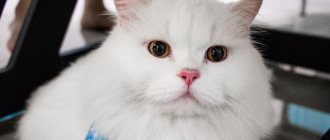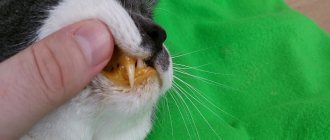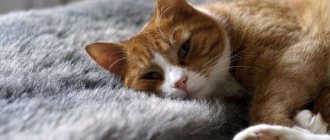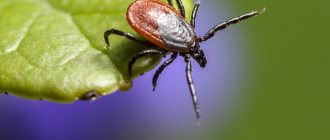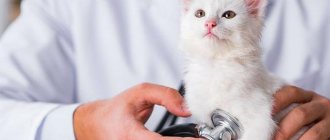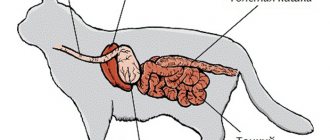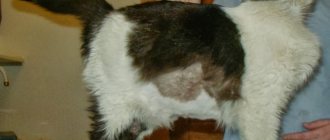Save article:
Many people believe that high blood sugar is a problem unique to humans. In fact, diabetes mellitus in cats (DM) is also quite common. To prevent illness in your pet, it is necessary to clearly understand the reasons that lead to its appearance. There are several signs that may indicate the development of diabetes in a cat. The treatment prescribed to the animal after diagnosis helps alleviate the condition and prolong its life.
What is diabetes mellitus and does it occur in cats?
global $ads_google; //data-ad-slot=”2475549904″ $ads_google = empty($ads_google) ? false : true; ?> if ($ads_google == false) {?>
$ads_google = true; ?> } ?>
Diabetes mellitus is an endocrine disease caused by dysfunction of the pancreas. This organ produces an important hormone, insulin, which helps glucose molecules migrate into cells. With its deficiency, carbohydrate accumulates in the blood, and tissues experience “hunger.”
An increase in the concentration of glucose in the bloodstream causes an increase in viscosity, as a result of which water from the cells rushes into the vessels. The tissues become dehydrated, and the animal's thirst increases. This process entails an imbalance in all types of metabolism: water-salt, protein, carbohydrate, fat. To get energy, cells begin to break down fats and proteins. A by-product of these reactions are ketone compounds, which are toxic to the body and have an acetone odor.
The normal blood sugar level for cats is 5.8 mmol/liter
Diabetes mellitus in cats is one of the common diseases. It occurs in cats much more often than in other domestic animals. According to statistics, a disease caused by insulin deficiency is diagnosed on average in every four hundred cats. And this figure is increasing every year.
Hyperglycemia and hypoglycemia
Elevated blood glucose is called hyperglycemia. Normally, this condition may be due to stress. Collecting biological material in a clinical setting is also a kind of stressful situation for a pet. Therefore, a one-time analysis is not informative. If there are no additional symptoms, a single increase in blood sugar level does not indicate an animal illness. It is necessary to repeat the study in as calm an environment as possible.
A short-term stress increase in an animal’s blood sugar level is not dangerous to its health. But if this condition continues for a long time, the cat’s body begins to produce large amounts of insulin.
Causes of diabetes in cats
Veterinarians identify several predisposing factors and causes for the development of diabetes mellitus in cats. These include the age, sex and weight of the animal. Males, especially neutered ones, develop diabetes more often than male cats. However, the risk increases when the pet reaches five years of age. Diabetes in kittens is extremely rare. Overweight pets are also a serious provoking factor for diabetes.
The main causes of diabetes in cats are:
- Unbalanced and excess nutrition.
- Lack of movement and exercise.
- The cat is experiencing severe stress.
- Liver diseases caused by viruses.
- Diseases of the digestive system.
- Unreasonable hormonal therapy.
- Hereditary predisposition.
Disease statistics
Domestic and foreign veterinary experts have noted an increase in diabetes mellitus among domestic cats over the past few years.
This is associated not only with the prevalence of the disease, but also with the expansion of diagnostic procedures in veterinary practice. According to statistical studies, 2 cats out of 1000 are susceptible to endocrine disease.
At the same time, veterinarians observe sex dependence in the formation of pathology: cats, unlike cats, are more likely to suffer from diabetes. It was also noted that the risk of developing the disease increases in castrated males. Experts associate this phenomenon with obesity. Pathology developing according to the second type accounts for approximately 2/3 of all cases.
According to statistics, the first symptoms of the disease in 50% of cases are found in pets after 5 years. The older the animal, the greater the likelihood of detecting an endocrine disease. It has also been noted that cats of the Burmese breed are more often than others susceptible to this pathology.
What are the types
Diabetes mellitus is divided into two types. Pathology of the first type develops when all beta cells die. They are responsible for the synthesis of insulin in the pancreas. This critical condition is rare among cats, accounting for approximately 20%.
global $ads_google; //data-ad-slot=”2475549904″ $ads_google = empty($ads_google) ? false : true; ?> if ($ads_google == false) {?>
$ads_google = true; ?> } ?>
Type 2 diabetes is characterized by only partial loss of beta cells. The pancreas produces insulin, but in insufficient quantities. This form is easier to treat, and veterinarians often give a positive prognosis.
How to treat diabetes insipidus in animals
A confirmed diagnosis requires immediate intervention and treatment:
- There should always be fresh and clean water near the dog's place (preferably not tap water, it contains many heavy macroelements, including sodium).
- For the central type - administration of an AGD analogue (desmopressin) - depending on the intensity of treatment: subcutaneous injections or drops.
- For the renal type, diuretics are used.
Important! Be very careful with the doses of the drug, accidental repeated administration of Desmopressin can lead to water intoxication - a drop in blood electrolyte levels, swelling of brain cells and irreversible damage.
The prognosis for the treatment of diabetes insipidus always leaves much to be desired. Remissions are extremely rare and are only possible with early treatment and extensive treatment of identified underlying causes. More often, the animal requires lifelong care and treatment. However, with proper understanding of the problem, the owner is able to provide the pet with a full life.
Treatment of central type diabetes, in the presence of renal diabetes, is a direct path to a heart attack! Do not self-medicate, be sure to consult a veterinarian!
Possible complications of diabetes
Progressive diabetes mellitus in a cat, especially insulin-dependent type I, is dangerous due to its complications. One of them is ketoacidosis, in which ketone bodies (keto acids) accumulate in the blood. This process causes a shift in the acid-base balance to the acidic side. Severe acidification of the body leads to dehydration, arrhythmia, tachycardia, and convulsions. Signs of diabetes accompanied by acidosis are nausea, vomiting, and diarrhea.
In cats, diabetic ketoacidosis is fatal in 1.5% of cases.
Infectious complications develop against the background of diabetes. A decrease in immune defense contributes to the rapid proliferation of pathogenic bacteria, viruses and fungi. This manifests itself in the form of intestinal disorders of an infectious nature, cystitis, kidney dysfunction, and skin diseases.
Another complication that occurs in cats due to diabetes is damage to peripheral nerves (neuropathy). The nerves innervating both internal organs and skeletal muscles are affected. This leads to muscle laxity, cramps, pain, loss of bladder control and other functional disorders.
How is diabetes insipidus diagnosed in cats and dogs?
Symptoms cannot guarantee the presence of a specific disease. Diabetes is a disorder of the body; the diagnosis can be confirmed or removed only after examination. After contacting the clinic, the animal will be prescribed:
- Blood and urine tests. The goal is to find out the density of urine, identify excess sodium in the blood (optional), and do tests for the concentration of ADH in the blood.
- Kidney examination.
- If a malfunction of the pituitary gland is suspected, administration of ADH from outside, restriction of fluid intake and control tests.
- MRI or tomography of the brain.
Depending on the test results, the severity of the condition is determined, and if necessary, therapy is carried out aimed at:
- Strengthening the cardiovascular system - carried out on the basis of a cardiogram.
- Blood purification - removes excess sodium and toxins.
- Kidney support.
- At the same time, synthetic ADH is administered and the reaction is monitored, the sensitivity of cells to the hormone is determined, and the required dose and dosage interval are set.
Symptoms of diabetes in cats
Often, in the first stages of development, diabetes mellitus in a cat goes unnoticed. Owners do not attach importance to the appearance of unusual symptoms, considering them minor deviations from the norm. However, every attentive owner should know the main signs of diabetes in animals. These include:
- Increased thirst, which is especially unnoticeable when feeding wet food.
- Increased urine output and increased frequency of urination.
- Increased appetite, developing due to poor absorption of glucose.
- Decrease in the quality of fur and its loss, the appearance of ulcers on the skin.
- “Shuffling gait” is a change in movement when walking and jumping due to weakness in the paws.
- Sudden changes in behavior when anxiety gives way to aggression or apathy.
- The specific smell of acetone emanating from the mouth, fur and urine.
- Increased heart rate – tachycardia.
Acetone odor is a sign characteristic only of type I diabetes
A diabetic cat tries to replenish its energy reserves by eating more food.
A characteristic symptom of diabetes in the later stages is weight loss. Due to the lack of insulin, glucose remains unclaimed, and the body tries to obtain energy through increased breakdown of fat deposits. In this case, primary obesity, which contributed to the development of the disease, goes into the opposite state.
Symptoms and diagnosis
Among all forms of diabetes mellitus in cats, the most rapid is insulin-dependent. At the beginning, the pathology is asymptomatic.
The main signs of the disease are as follows:
- increasing the volume of fluid consumed;
- frequent urination;
- increased thirst;
- the appearance of itching and dryness on the skin and mucous membranes;
- increased appetite;
- weight loss;
- insomnia;
- weakness;
- decreased vision;
- convulsive state;
- specific smell.
With insulin-dependent diabetes, in addition to severe thirst, cats often experience nausea and vomiting. Other symptoms include increased fatigue, lethargy, drowsiness, and excessive appetite.
Although the animal eats more than usual, there is a rapid decrease in body weight and a sickly appearance.
With this form of the disease, cats, in addition to frequent urination, sometimes develop enuresis (urinary incontinence). Most often, the condition manifests itself at night; the pet gets up from a wet bed after sleep.
Nocturia provokes itching, the cat scratches itself and the wounds do not heal for a long time, this, in turn, can cause infection with pathogenic bacteria.
Due to the non-insulin-dependent form of diabetes, vision is often impaired in pets. The cat develops a skin infection that is accompanied by itching. The animal becomes drowsy, almost always lies down, and does not want to play. Occasionally there is low sensitivity in the limbs and the occurrence of seizures. In addition, the wool loses its shine and often becomes tangled.
In the absence of any action at this stage, a strong decrease in the pet’s immunity occurs, which is why secondary infections are added to diabetes.
In addition, there is a disorder in metabolic processes, which can cause brittle bones in a cat.
Diabetes mellitus cannot be diagnosed based on symptoms alone. To determine exactly what disease is developing in an animal, a veterinarian may prescribe the following examination methods:
- general blood and biochemistry;
- ultrasonography;
- general urine analysis.
Sometimes a sugar tolerance test is required. In this case, a rapid urine test is usually used using a special glucose-sensitive strip.
Diagnosis of the disease
Even if several symptoms of diabetes are detected, a precise diagnosis cannot be made. This requires laboratory testing. For diagnosis, a quantitative analysis of glucose in the blood and urine is performed. The test is repeated several times, since excess carbohydrate concentration may be a one-time occurrence. It is caused by stress. The interval between tests is from one to five days.
In some cases, the veterinarian may suggest testing not for sugar, but for fructosamine in the blood. This compound is formed as a result of the interaction of glucose with blood proteins. Quantitative analysis of fructosamine helps determine the stage of diabetes and subsequently monitor the effectiveness of treatment.
Before the test, the cat cannot be fed, since the blood is taken on an empty stomach.
If a cat has diabetes, it is useful to find out the exact amount of water consumed by the animal. The clinic also prescribes an ultrasound scan of the abdominal organs (pancreas, liver, gallbladder) to identify structural pathology. If your pet exhibits concomitant symptoms of heart disease, the doctor recommends a cardiac examination.
How to measure blood sugar levels
global $ads_google; //data-ad-slot=”2475549904″ $ads_google = empty($ads_google) ? false : true; ?> if ($ads_google == false) {?>
$ads_google = true; ?> } ?>
A diabetic cat needs to have its glucose levels checked regularly. To do this, you need a special device (glucometer with test strips) and a drop of blood. The device is turned on and a test strip is installed in it. A code should appear on the screen that matches the code on the strip package. After this, the numbers are replaced by the image of a drop. This means that the device is ready for use.
A 21-23 G needle is installed in the piercing pen. Blood for express analysis of the pet is taken from the tip of the auricle or paw pad. If the cat has long hair on the ears, then it is cut in a small area so that it does not interfere with the piercing. Before taking blood, the skin should not be wiped with alcohol, lotion, or gel. The piercing pen is placed on the edge of the auricle and a puncture is made. The released red drop is applied to a test strip inserted into the glucometer. The injection site is wiped with a disinfectant (peroxide, chlorhexidine, alcohol).
How to control your cat's sugar levels
After establishing a diagnosis and prescribing treatment, the owner of a sick animal faces an important task - monitoring the level of sugar in biological fluids. The most common way to monitor at home is test strips for determining sugar in urine. With their help, the owner has an idea of the animal’s condition and can adjust the diet or take appropriate measures.
A more accurate control method is veterinary glucometers. They are used in severe cases of diabetes, when it is necessary to have a clear understanding of the sugar level in the body.
We recommend reading about treating cat eye discharge. You will learn about the types of discharge from the eyes, the causes of purulent discharge, treatment, and rules for washing the eyes. And here is more information about why cats have bad breath.
Treatment of diabetes in cats
Therapy for diabetes includes various medications in tablet and injection form. The main goal of diabetes treatment is to achieve remission, when glucose does not rise above 8-10 mmol/liter and there is enough insulin in the body. It is not recommended to lower this indicator more in sick animals, since in this case hypoglycemia develops. The treatment strategy, which can only be determined by a doctor based on clinical data, depends on the type of diabetes, the age of the pet and concomitant diseases.
If a cat develops type I diabetes, the main treatment drug is short-acting insulin. Based on the cat’s weight and the needs of its body, the doctor calculates the dose and frequency of administration of the medicine. To relieve ketoacidosis, the cat is given injections with a small amount of insulin, but their frequency exceeds the usual rate, which is 2 times a day. After stabilizing the glucose concentration, they switch to treatment with intermediate- and long-acting insulin (Caninsulin). It is administered in the morning and evening, making an injection into the withers or thigh.
For cats with type II diabetes mellitus, it is advisable to use tablets that lower blood sugar: Glipizide, Metformin, Acarbose, Gliquidone, Miglitol. The use of these medications should be supervised by a veterinarian, as most of them have the side effect of amyloidosis. At the same time, a complex substance of protein-carbohydrate origin is deposited in the tissues of the body, which leads to atrophy and functional failure of organs.
During treatment, it is necessary to keep a log and draw up a graph called a sugar curve.
Is it possible to completely cure an animal?
The effectiveness of treatment for diabetes in pets depends on the stage of the disease, compliance with all recommendations prescribed by the veterinarian, and diet. In very severe cases, when the pathological process has gone far, doctors give a very cautious prognosis. In this case, everything depends on timely assistance to the animal and the internal reserves of the body.
With a mild course of the disease, not aggravated by complications, a favorable outcome is possible. By stabilizing glucose concentrations at an optimal level and supporting them with dietary nutrition, you can expect your beloved pet to live a long life. Its quality and duration in this case are the same as those of healthy family members.
Causes of abnormal blood sugar levels in animals
Therapy with hormonal drugs can lead to an increase in glucose levels in the animal's blood. Against the background of hormonal therapy, an increase in the animal’s body weight and metabolic disorders are often observed.
Endocrine diseases, such as an overactive thyroid gland, can lead to diabetes. Increased blood sugar levels may be associated with some liver diseases, because they are also often associated with diabetes. Acute pancreatitis and irritation of the animal’s central nervous system can cause an increase in blood sugar.
Diabetes mellitus occurs with characteristic symptoms: severe thirst, the animal is constantly thirsty, and urinates frequently and profusely. The cat may develop polyphagia and obesity, or, conversely, the cat may suddenly lose weight. The animal becomes lethargic and gait is impaired. The content of ketones and sugar in the urine increases.
Poisoning your pet with chloroform or benzene can lead to a decrease in blood sugar. In this case, the cat experiences increased drowsiness, decreased body temperature, weakened breathing, and pale visible mucous membranes. Without proper medical care, the animal may die if the poisoning is severe.
An overdose of insulin, disruption of the endocrine glands, and some diseases of the kidneys and small intestine lead to a decrease in glucose levels. The general condition of the cat is disturbed. The animal feels hungry, often licks its lips due to nausea, and may vomit. The cat may have disorientation and inappropriate behavior.
Hypoglycemia is the leading symptom of insulinoma. This is most often a malignant neoplasm of the pancreas that secretes insulin. In cats, this disease can be accompanied by seizures, depressive disorders, anorexia, thirst and frequent urination.
Diet
global $ads_google; //data-ad-slot=”2475549904″ $ads_google = empty($ads_google) ? false : true; ?> if ($ads_google == false) {?>
$ads_google = true; ?> } ?>
Since a cat with diabetes has impaired food reactions and metabolism, it is very important to adjust the diet. Importance is given to the quality, quantity and frequency of feeding. It is recommended to feed a sick cat in small doses: 5-6 times a day. Portions should be small. This approach allows you to remove the load from the pancreas, when it is forced to produce a large amount of hormone at a time to process all the glucose that comes with food. Frequent, minimal feedings ensure stable insulin levels throughout the day.
If the cat is on insulin therapy, then an insulin injection must be given at one of the feedings.
The next rule of diet is nutrient balance. Food for a diabetic cat should contain a maximum of protein and a minimum of carbohydrates. An exception is made only for plant fibers. Fiber, which is not digested in the cat’s gastrointestinal tract, slows down the breakdown of sugars and the absorption of glucose. Due to this, carbohydrate enters the blood more slowly.
Food for diabetic cats
Modern manufacturers produce various types of food for cats suffering from diabetes. They contain ingredients allowed for this disease: animal and vegetable protein, fiber, rice, corn flour. Most products do not contain vegetables or herbs. The average amount of protein in them is 45%, fat – 18%, carbohydrates – 20%. To increase the cat's appetite, liver or chicken flavors are included in the food mixture.
The most well-known brands of therapeutic diabetic food are:
- Royal Canin Veterinary Diet-Diabetic
. The protein component is represented by chicken and soy flour. Contains grains: corn and barley. Plantain seed fiber was used as plant fiber, which regulates the functioning of the gastrointestinal tract.
- Purina Veterinary Diets
. Dietary products from Sweden. It tastes like liver and contains chicken by-product flour, soy protein, animal fat, and corn starch.
- Farmina Vet Life Diabetic
. A distinctive feature of this brand is the high content of biologically active substances (antioxidants, L-carnitine, taurine, inulin). The carbohydrate component is represented by oats and pea fibers.
- Hills Prescription Diet w/d
. In addition to animal protein, chicken by-product flour and cereals, L-carnitine is included in the composition. This substance helps break down fats and maintain the cat's weight.
- Young Again Zero Carb Cat Food
. American brand product. Contains chicken flour, pork protein, herring flour, fatty acids.
- Young Again 50/22Cat Food
. A variation of the previous food, which is distinguished by the presence of tomato cake and potato starch. The total amount of carbohydrates in it is only 4.6%.
If your pet has contraindications for consuming medicinal food (for example, kidney failure) or signs of intolerance, then it is necessary to develop an individual diet made from natural products. This is best done together with a veterinarian. He will tell you the range of permitted and prohibited products.
Blood sugar in a cat: norm and excess
They produce Glucose 5, 10, 25, 40% solution for injection packaged in 10, 20.50, 100, 200, 250, 400 and 500 ml in sterile hermetically sealed glass vials or bottles, sealed with rubber stoppers and rolled in aluminum caps. Each package is marked with the following indication: the name of the manufacturing organization, its address and trademark, the name of the drug, the name and content of the active substance, the method of use, the batch number, the date of manufacture, the expiration date, the amount of the drug in the bottle, storage conditions, the inscription “Sterile” ", "For animals", designations specifications and are accompanied by instructions for use. Store in a dry place, protected from light, out of reach of children at a temperature of 00 to 25 0C. Shelf life, subject to storage conditions, is 2 years from the date of manufacture. Glucose 5, 10, 25, 40% injection solution should not be used after the expiration date.
II. PHARMACOLOGICAL PROPERTIES
5. In veterinary medicine, isotonic (5%) and hypertonic (10, 25, 40%) glucose solutions are used for injection. An isotonic glucose solution is used to replenish the body with fluid and easily digestible, valuable nutritional material. In tissues, glucose breaks down and releases energy. Hypertonic glucose solutions increase the osmotic pressure of the blood, improve metabolic processes, antitoxic liver function and heart function, dilate blood vessels, and increase diuresis. Glucose stimulates the synthesis of hormones and enzymes, increases the defenses of the animal's body.
6. After administration, the drug is quickly absorbed from the injection site and distributed in the organs and tissues of the animal. According to the degree of impact on the body, Glucose 5, 10, 25, 40% solution for injection according to GOST 12.1.007-76 belongs to low-hazard substances (hazard class 4).
III. ORDER OF APPLICATION
7. Glucose 5,10,25,40% injection solution is used in animals with large losses of body fluid (bleeding, toxic dyspepsia), shock, intoxication, metritis, vaginitis, as well as for dissolving various medications.
8. Glucose 5% solution for injection is used subcutaneously or intravenously, and glucose 10,25,40% is used intravenously in the following doses (ml per animal):
| cattle | 2000 – 5000 |
| horses | |
| small cattle | 100 — 300 |
| pigs | 100 — 200 |
| dogs | |
| cats |
Doses and timing of use depend on the weight of the animal and the course of the disease. When administered subcutaneously, the dose of the drug is administered fractionally to different places.
9. In recommended doses it does not cause side effects or complications in animals.
10. The use of Glucose 5, 10, 25, 40% solution for injection does not exclude the use of other medications.
11. There are no contraindications to the use of Glucose 5, 10, 25, 40% solution for injection.
12. Livestock products during and after the use of Glucose 5, 10, 25, 40% solution for injection are used without restrictions.
Read/leave a review about the veterinary drug Glucose 5%
Prevention of diabetes mellitus in cats
Given all the challenges and consequences associated with diabetes in cats, it is important to remember and implement preventive measures. They are simple and accessible for every owner of a fluffy cat. Firstly, the cat needs to be given a balanced diet in optimal quantities. This point is taken into account even for a kitten, since it may have a hereditary predisposition to obesity and insufficient insulin synthesis.
Secondly, every cat needs regular “sports.” Active games and walks in the fresh air will help her stay fit and healthy. Thirdly, an important point in prevention is medical examination. Periodic (once a year or six months) examinations and tests will help identify the disease at the very beginning, even if symptoms have not yet appeared. During this period, it is much easier to achieve a positive result and completely restore the animal’s health.
Attentive attitude towards your pet is the key to his long healthy life and peace of mind of the family in which he lives. Diabetes mellitus in cats is a serious but treatable disease. If desired, it can be kept under control, thereby making the pet feel better.
The norm of sugar (glucose) in cats and dogs in the blood and urine
The owner, seeing high glucose values, raises the dose of insulin, and a new, deeper drop in glucose results. How to install Samoji Syndrome and what to do? Measuring glucose levels between control (morning and evening) measurements helps to establish the lowest glucose value of the daily curve - it is called Nadir. It is for the prevention of hypoglycemia and Samoji syndrome that endocrinologists recommend that owners measure blood glucose levels more often (at least once every 2 hours during the first 4-5 days). This is not easy, as it requires a lot of attention to the animal. But, this significantly reduces the risks of hypoglycemia. If Samoji syndrome is established, the first thing I recommend doing is reducing the insulin dose by 0.5 units. The first two or three days, with control measurements, the results will be high, but the Nadir will also become higher, which means the level of secreted counter-insular hormones will be lower, which will lead to smoother and less high rises in glucose. What to feed a diabetic cat? In the veterinary food market, I would highlight three super-premium foods: Royal Canin diabetic, Hills w/d and Purina dm. It is important that the cat eats the medicinal food offered. In case of categorical refusal, you will have to feed what the cat eats; it is extremely undesirable for a diabetic cat to starve. Diabetic medicinal foods, even without the use of insulin (but they cannot replace it), reduce blood glucose levels. In general terms, I have covered the main issues that concern owners of cats with diabetes. About the algorithm: the numbers indicated by me may not coincide with the data of my colleagues, but the main thing here is to understand the principle, and a discrepancy of 1-2 mmol/l is not so important. Treatment of diabetes mellitus in cats is nervous and difficult at the first stage, troublesome, and requires the development of new skills. However, most cats have a good chance of achieving remission. I am available (via what's app, viber, telegram or phone), ready to answer any question regarding the selection of insulin dosage and, on the condition of the animal, in general. Contact us!
Vladimirov Vladimir Anatolyevich, veterinary physician-endocrinologist.
Mortality of newborn kittens from the triad “hypoglycemia, hypothermia (hypothermia), dehydration”
by Alisa » April 01, 2013, 08:13 pm
Mortality of newborn kittens from the triad “hypoglycemia, hypothermia (hypothermia), dehydration” 01/16/2013
The above syndrome develops very often in kittens, but it can also be easily stopped if its signs are noticed in time. The kitten is born immature and weak: it has insignificant reserves of carbohydrates, until 3 weeks of age it is not able to regulate body temperature, and the protective functions of the skin are in their infancy. All this increases the susceptibility to hypoglycemia, hypothermia and dehydration. Hypoglycemia in kittens
A kitten is born without significant energy reserves in the form of glycogen in the liver and muscles. He lacks brown adipose tissue, which is responsible for non-shivering thermogenesis. And finally, the functions of some regulatory organs (for example, the liver) are not yet stable. Therefore, a kitten can only maintain optimal blood glucose levels with regular feeding.
Consequently, in the neonatal period he is predisposed to the development of hypoglycemia. Hypoglycemia is expressed in apathy, lethargy, and sometimes the kitten experiences convulsions.
If the cat does not have enough milk (very large litter, delayed lactation), it is necessary to prepare bottles with cat milk replacer (be sure to measure the rectal temperature before drinking).
If the veterinarian has confirmed the diagnosis of hypoglycemia, he can administer a glucose solution parenterally to the kitten. It is generally accepted that administering a glucose solution subcutaneously is not very effective and is sometimes even dangerous if it is too concentrated. Hypothermia in newborn kittens
The procedure for measuring rectal temperature is very simple, quick and useful for monitoring the condition of newborn kittens.
Evaporation of fetal fluid from the surface of the skin leads to hypothermia. The kitten is unable to regulate its body temperature during the first weeks of life. Let us repeat once again that the reason for this is the imperfection of the autoregulation (thermoregulation) system. For example, the trembling reflex appears only at 6-7 days of life.
Hypothermia in a kitten is initially expressed in the loss of interest in it on the part of the mother. Then his digestion processes stop: at temperatures below 34 ° C, the kitten is not able to digest food. Therefore, before offering him a bottle
with milk, you must ensure that its rectal temperature is above 34 °C. During post-mortem examinations, milk is often found in the respiratory tract of bottle-fed kittens. Thus, a kitten may choke on milk if it is given when the kitten's sucking reflex is reduced (32-34 °C). A kitten always instinctively strives for warmth. He looks for a living creature nearby and presses his body against the mother and other kittens of his litter. It is necessary to warm up a “frozen” kitten gradually. To avoid hypothermia in kittens, it is important to control the temperature and humidity of the nest; if necessary, use external heat sources. Use caution when using infrared lamps.
How to take blood from a cat to test for sugar?
The most convenient way to collect blood from a cat is from the auricle. To see the vessels, the ear is illuminated with a flashlight. Before taking blood, you cannot disinfect your ear!
Blood can also be taken from the paw pads.
- Use any medical or veterinary blood glucose meter.
- Turn on the glucometer and insert a test strip into it.
- Pierce the ear or paw pad with a needle. Wait for a drop of blood to appear, then apply the test strip to the drop of blood.
- Insert the strip into the glucometer and wait for the result.
- Treat the puncture site with chlorhexidine.
Tip: If blood spreads across the ear, shave it or lubricate the fur with a thin layer of Vaseline.
Ready-made food for cats with diabetes
It is very convenient to feed mustachioed pets with ready-made industrially produced diabetic food - dry and wet. It is best to give elderly cats wet food and canned food - they are better digested and absorbed by an already middle-aged body. The dosage and frequency of feeding is indicated on each package or can. All ready-made foods for diabetic cats contain a large amount of protein and practically no carbohydrates.
- Young Again Zero Mature Health Cat Food ($32/1.8 kg dry);
- Young Again 50/22 Cat Food ($44/3.6 kg dry);
- Purina Veterinary Diet DM Dietetic Management (about RUB 1,200/1.5 kg dry);
- Purina Pro Plan (about 1,200 rub./1.5 kg dry, 130 rub./195 g dry food, up to 100 rub./85 g wet food);
- Vet Life Cat Diabetic (about RUB 1,900/1.2 kg);
- Prescription Diet Feline m/d (about 1500 rub./1.5 kg, 140 rub./156 g cons.);
- Royal Canin Diabetic DS46 (RUB 1,300/1.5 kg);
- Royal Canin Diabetic (RUB 75/100 g wet food).
Forecasts and statistics
A favorable prognosis is typical only for type 3. In other cases, the disease is incurable. Despite this, strict adherence to all medical recommendations makes it possible to stabilize the patient’s condition and prevent relapses. Thanks to proper care, a furry diabetic can live as long as healthy animals.
According to statistics, improvement in well-being is observed even in animals with an advanced form of the disease. But in such situations, veterinarians give a cautious prognosis, since some complications can become an insurmountable obstacle to recovery.
Causes of development in dogs
Diabetes insipidus has several varieties, characteristic of absolute or relative deficiency of ADH.
Central diabetes insipidus
The cause of diabetes is an insufficient amount of insulin, which is caused by metabolic disorders. With this disease, individuals begin to consume a lot of food that is not digested. Existing wounds on pets are difficult to heal.
Next, we will look at the traditional causes of diabetes in cats.
- Poor nutrition. It not only leads to hair loss, vomiting or diarrhea, various digestive problems (gastritis, ulcers, enteritis, pancreatitis), but also metabolic disorders. But this already leads to diabetes. In general, we can talk about the consequences of poor nutrition for a very long time.
- Heredity. It is no secret that a predisposition to diabetes is passed on from parents to children.
- Obesity. This is rather a predisposing factor. After all, excess weight is a consequence of metabolic disorders.
- Physical inactivity. If the animal moves little, then excess weight quickly gains. As you can see, almost all the reasons are closely related.
- Chronic stress. Again, due to nerves, digestive problems appear. Due to stress, the cat does not want to move, but now “seizes” him. Which again leads to obesity and changes in metabolism.
- Viral infections. Especially those that affect the digestive tract and lead to pancreatitis (inflammation of the pancreas) and hepatitis (inflammation of the liver).
- Chronic diseases of internal organs.
- Hormone therapy. In general, you need to be careful with hormones. Without a veterinarian, the uncontrolled use of such drugs is very dangerous, leading to changes in overall hormonal levels. In addition to diabetes, your cat may have other health problems.
According to veterinary therapists, the causes of central diabetes insipidus in dogs include, first of all, injuries and concussions of the brain and neoplasms (tumors, cysts). Often, congenital pathologies in the structure of the hypothalamic-pituitary part of the brain lead to the development of the disease.
Experienced dog breeders note that most often congenital pathology of the hypothalamus with the subsequent development of diabetes insipidus is characteristic of the Afghan hound. Underdevelopment of the pituitary system (nanism) is characteristic of the German Shorthaired Pointer.
The cause of the development of central diabetes insipidus in four-legged pets can be infectious and parasitic diseases. Encephalitis and meningitis are a common cause that leads to disruption of the production of antidiuretic hormone in the brain. Prolonged oxygen deprivation and fever can also disrupt the normal production of the hormone.
The nephrogenic type of disease, according to veterinary experts, is usually a consequence of severe intoxication and an inflammatory process in the kidneys. The cause of diabetes insipidus of renal origin is often nephrosis.
The disease is characterized not only by inhibition of kidney function, but also by a decrease in the sensitivity of the renal tubules to the action of the antidiuretic hormone produced by the hypothalamus.
Why treatment doesn't help
The faster you take measures to combat the disease, the faster your pet’s condition will improve. First of all, you need to pay attention to the cat’s nutrition. If you are overweight, you need to rid your pet of high-calorie foods. To increase the animal's increased activity, you need to carefully review the cat's menu. This simple measure of compliance will improve the condition of the animal.
If you have type 1 diabetes, the food should be high in calories, but you cannot force your pet to eat food. Nutrition for this type of diabetes involves taking small portions, as glucose levels can rise sharply.
Fluid intake should be reduced to a sufficient amount. With this type of disease, it is advisable to give your pet a quick-acting insulin injection.
The injections are used twice a day before starting to eat. The dosage is determined by the veterinarian.
If you have type 2 diabetes, you need to take food 4-5 times a day, in small portions. The food should not contain carbohydrates, it should contain foods rich in protein, and also boiled vegetables.
It is recommended to give preference to ready-made food containing ready-made components for a sick individual. Sometimes there is the use of drugs in tablets that lower blood sugar.
In rare cases, insulin may need to be administered.
During diabetes insipidus, it is recommended to maintain a fluid regime; water consumption should be frequent. The food of an animal suffering from this disease should consist of semi-liquid dishes (mashed soups, fermented milk products) and vegetables.
For better results, use the drug desmopressin. It is an eye drop that must be used in an amount of 1-2 drops.
They are injected under the pet’s eyelid no more than twice a day. Drops can be used as injections that need to be injected under the skin of an individual.
The dosage is considered to be 2-5 mcg no more than twice a day.
The most important thing is that a cat with diabetes cannot be treated with “human” drugs.
- Firstly, many of them are simply not suitable for animals.
- Secondly, they are not effective against pets.
| First type | To treat an animal suffering from type 1 diabetes mellitus, fast-acting insulin (injectable) is used. However, if the problem is that the cells do not perceive the hormone, then the approach will be different: you will have to select drugs experimentally, observing the cat’s condition over time. Treatment is expensive and lifelong. Not all owners go for this. |
| Second type | It's a little easier here. Long-acting insulin will be needed. It is softer, and this drug is not always administered intramuscularly. There are also analogues that are given orally. They slowly reduce glucose concentrations (not sharply). |
| Third type | First of all, you need to get rid of the root cause. Eliminate it, and your cat’s diabetes will disappear. |
Treatment of a cat for diabetes should always be under the supervision of a veterinarian. There are severe cases when the usual scheme is ineffective.
This is recorded extremely rarely, but it still happens. For example, when a cat has a true “non-acceptance” of insulin, or the so-called Somogyi effect (at first, blood sugar drops sharply, and then also rapidly rises).
Or a very fast metabolism, then the injected insulin will be excreted almost immediately. Sometimes an animal has antibodies to insulin, then it’s really difficult.
But there are also trivial reasons when treatment does not help. This is when the drug itself was stored or administered incorrectly. Or if other hormones are taken in addition to insulin. And also if the cat still has diseases (root causes). For any type of diabetes, diet therapy is important. Without it, you will have to constantly feed your pet with insulin and its analogues.
Diet therapy
The diet should consist of protein foods. Minimum carbohydrates!
After all, it is during the breakdown of carbohydrates that glucose is released in the blood. Proteins do not give such a sharp jump, and blood sugar is within normal limits.
Of course, it will not be possible to completely eliminate carbohydrates, because even in small quantities, they are present in almost every food product. And feeding only protein foods is dangerous.
The kidneys will fail. And your metabolism will slow down even more.
As a result, diabetes will worsen.
Almost all veterinarians suggest that owners switch their cat to ready-made super-premium dry medicinal food or a holistic class food that is suitable for animals with diabetes. Everything is balanced there.
Another important point. You will have to feed often!
Do you know the essence of fractional nutrition? This is when often, but in small portions. Firstly, this way the animal will always be full. Secondly, blood glucose will slowly increase. Thirdly, fractional meals help speed up metabolism, which leads to recovery. How often - the veterinarian will decide. Everything is calculated individually, based on the severity of the disease.
Insulin is administered during feeding (a liquid preparation that can be given orally is convenient) or immediately after.
The therapeutic strategy depends mainly on the cause of the endocrine disorder. In the event that the disease is caused by a violation of the production of vasopressin, then treatment is of a replacement nature.
A sick dog is prescribed an antidiuretic hormone analogue. Desmopressin is a synthetic substitute for vasopressin that enhances water reabsorption in the kidneys and increases urine density.
The drug is used in the form of drops subconjunctivally, as well as in the form of subcutaneous injections. Desmopressin is used under the strict supervision of a veterinarian, since an overdose leads to serious intoxication of the body.
To alleviate the condition of a sick pet, blood purification through intravenous injections and sodium removal from the body helps. In the case of a nephrogenic type of disease, diuretics have a good effect.
Complex therapy for endocrine disease includes drugs to maintain kidney function and the cardiovascular system.
After confirmation of the diagnosis, a difficult time begins for the owner. Treatment of this disease is very long-term and includes a set of measures.
Therefore, some owners decide to euthanize the animal. But with a patient owner, a cat can be cured and live for many more years.
The main thing is to follow all the doctor’s recommendations. Only a specialist understands how to influence diabetes in a cat.
Its symptoms and treatment are similar to the course of the disease in humans, so insulin injections are most often prescribed.
The difficulty is to choose the right dosage of the drug. Therefore, after the first administration of the approximate dose, it is necessary to measure blood glucose levels every 2 hours. Based on these data, the doctor draws conclusions about the characteristics of insulin absorption and adjusts the dosage and time of administration of the medicine.
What other way can you influence diabetes in a cat? Treatment also consists of a special diet and nutrition regimen. Sometimes glucose-lowering drugs are used in the form of tablets, but they very often have side effects. Cats are prescribed the same medications as humans, but in a different dosage. Most often these are Acarbose, Metformin, Glipizide.
Examination of an animal at home
To make life easier for pets and their owners, special glucometers for animals were released for sale. The principle of their operation is similar to the same devices for measuring glycemic levels in humans. The device is equipped with test strips onto which a drop of the subject's blood is applied.
Important! In cats, biomaterial for research is taken not from the pads on the paws, but from the tips of the ears. Here the vessels are located close to the surface, which means the collection occurs quickly and almost painlessly. . Veterinary pharmacy also suggests using express strips to assess urine sugar levels (for example, Uriglyuk)
The method for determining the presence of glycosuria will not always tell whether the glycemic levels are normal, but it will detect critical conditions.
Veterinary pharmacy also suggests using express strips to assess urine sugar levels (for example, Uriglyuk). The method for determining the presence of glycosuria will not always tell whether the glycemic levels are normal, but it will detect critical conditions.
Doctors recommend measuring your sugar levels at home daily. If the examined animal is for any reason in a veterinary clinic, glucose levels are assessed every few hours.
OneTouch Ultra is an excellent option for a home glucose meter
What happens in the body during diabetes
The disease is associated with dysfunction of the pancreas. Under normal conditions, it produces insulin, which is necessary for the absorption and processing of glucose. This substance is necessary for the proper functioning of the brain and other organs. It is a source of nutrients and energy. If the functions of the gland are disrupted for some reason, there is not enough glucose in the body. It is not absorbed, but circulates freely through the blood. All organs suffer from this.
First of all, glucose accumulates in the kidneys, taking all the fluid with it. In this case, the body suffers from dehydration, the animal feels intense thirst and the need to urinate frequently. In addition, cells lack nutrients and energy. The brain begins to use glycogen reserves in the liver and extract energy from proteins and fats. This leads to disruption of the functioning of various organs in the animal.
